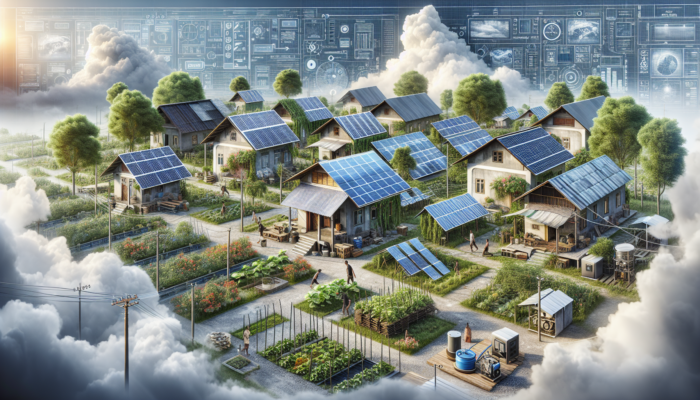Mastering the Art of Grid Failure Management: Essential Strategies for Preparedness
When an unexpected blackout occurs, it’s completely normal to feel anxiety and fear creeping in. However, staying calm and collected is vital for mastering the management of a grid failure. Blackouts can arise from various sources, including natural disasters, technical malfunctions, or cyber threats, and can profoundly disrupt your daily life. Therefore, being thoroughly prepared and knowing how to respond effectively are essential for ensuring your safety and comfort during these stressful situations. This comprehensive guide offers indispensable insights into managing a grid failure, featuring actionable strategies, professional advice, and answers to crucial questions that empower you to navigate these incidents with confidence and skill.
Comprehensive Planning for Grid Failures: Key Steps You Must Take

Preparing effectively for a grid failure involves much more than just having a rudimentary plan; it necessitates a detailed strategy that includes various essential survival components. By proactively preparing, you can substantially lessen the effects of a power outage, arming yourself with vital tools and extensive knowledge to navigate disruptions with confidence and ease. Take the necessary time to assess your personal needs, gather indispensable supplies, and familiarize yourself with the specific characteristics of your environment, ensuring you are well-equipped for any unforeseen events that may occur.
Critical Items for Your All-Inclusive Emergency Kit: An Essential Checklist
A well-prepared emergency kit forms the backbone of your preparedness strategy. Begin by incorporating vital items such as flashlights, batteries, first aid supplies, and a multi-tool. Additionally, it’s crucial to stock up on non-perishable food items and bottled water, aiming for at least one gallon per person per day for a minimum of three days. You should also consider including a portable phone charger, any necessary medications, and personal hygiene products. In the context of surviving a grid failure, access to these supplies can be the determining factor between chaos and a feeling of control.
Customizing your emergency kit to suit specific personal needs is vital; for example, families with young children should be sure to include baby food and other essential supplies. Regularly review and refresh your kit to ensure that food and medications are within their expiry dates. A thoroughly prepared emergency kit not only provides peace of mind but also serves as a lifeline during prolonged outages, allowing you to maintain your health and comfort throughout the ordeal.
Proactive Measures for Anticipating and Preparing for Power Outages
Strategic planning is essential for confidently managing the unpredictable nature of grid failures. Begin by assessing your home’s vulnerabilities—identify which appliances are absolutely essential and consider investing in a generator to ensure you have backup power. In addition, solar-powered chargers and battery packs can be invaluable assets for keeping smaller devices functional during outages. The goal is to have multiple methods to maintain essential functions within your home and ensure ongoing comfort and safety.
Establishing a clear communication plan with family and friends is also critical. Designate a central meeting point and ensure everyone knows how to reach one another during a power outage. Staying informed about your area’s infrastructure and potential risks is paramount; local news outlets and social media channels can provide real-time updates that are crucial for surviving a grid failure and making informed choices.
Effective Strategies for Communicating During a Grid Failure

Effective communication during a grid failure is both challenging and vital for ensuring safety. Conventional communication methods may falter in the absence of a reliable power supply. To stay updated, it’s wise to invest in a battery-operated or hand-cranked radio to receive emergency broadcasts and updates. Make sure that all mobile devices are fully charged, and consider utilizing text messages or social media platforms to communicate, especially when cellular networks become overwhelmed.
Creating a group chat with family and friends can help keep everyone informed about any changes or developments. Information is undeniably your most valuable asset during a grid failure—knowing where to find resources, shelter, or assistance can significantly alleviate anxiety and enhance safety for you and your loved ones.
Best Practices for Storing Food and Water During Emergencies
Ensuring food and water security is a non-negotiable aspect of preparing for a grid failure. Stock up on non-perishable items such as canned goods, dried fruits, and nuts. Use airtight containers to preserve food freshness and protect it from pests. Implement a rotation system to ensure older items are consumed first, thereby minimizing waste and ensuring access to safe, consumable food.
Water storage is equally important. If possible, consider installing a rainwater harvesting system or invest in a water filtration system to secure a clean and safe supply. Familiarizing yourself with household methods to purify water can also prove tremendously beneficial. Access to safe drinking water during a power outage is critical, so adopt best practices for surviving a grid failure by ensuring that you have sufficient and easily accessible supplies.
Real-Life Scenarios for Successfully Navigating a Grid Failure
Different environments present unique challenges during a grid failure. Understanding these differences can help tailor your approach, whether you find yourself in a rural setting or a bustling urban area.
Unique Challenges and Solutions for Rural Residents During Power Outages

Living in a rural area often means longer distances to essential resources, making thorough preparation especially critical. Due to limited infrastructure and resources, individuals in these areas may experience prolonged power outages. Therefore, consider investing in alternative energy sources such as solar panels to guarantee a reliable backup power supply. These systems can significantly boost your resilience and self-sufficiency during a grid failure.
Building a strong community network can also provide immense support. Collaborating with neighbors to share resources, generators, or supplies can enhance preparedness for everyone involved. Furthermore, ensuring that your home is equipped for self-sufficiency—such as growing your own food and having reliable water sources—can greatly enhance your ability to thrive during a grid failure.
Survival Strategies for Grid Failures in Urban Environments
In urban settings, the high population density and existing infrastructure can complicate survival efforts during a grid failure. Tall buildings may lack adequate emergency lighting and ventilation, making it crucial to have a well-thought-out contingency plan. While stocking up on essential supplies is imperative, it’s equally important to be aware of local resources—identify nearby emergency shelters and community centers that can provide assistance if required.
Traffic congestion can quickly escalate into a major concern during urban outages, making it essential to familiarize yourself with alternative routes and transportation options. Having a bicycle or another means of transportation can be highly advantageous when surviving a grid failure in a city environment, allowing for greater mobility and access to necessary resources.
Long-Term Survival Strategies for Prolonged Grid Failures: Preparing for the Unexpected
Prolonged grid failures can dramatically disrupt your daily routine and necessitate a sustainable plan for living. Focus on achieving energy independence by investing in renewable energy systems such as solar or wind power. These systems can reliably provide energy, thereby reducing your dependence on the grid and enhancing your resilience during extended outages.
Creating a community support network can further strengthen your survival strategy. To promote resilience, organize training sessions that focus on food preservation, gardening, and essential survival skills. The more knowledge and expertise you and your community possess, the better equipped you will be to manage prolonged power outages.
Immediate Steps to Take During Short-Term Outages: Ensuring Safety and Comfort
When confronted with a short-term grid failure, immediate actions can play a significant role in maintaining comfort and safety. First, turn off and unplug appliances to prevent potential damage when power is restored. Utilize candles and flashlights for illumination, but exercise extreme caution to avoid fire hazards associated with open flames.
Examine your emergency kit to confirm that you have everything you need for comfort and safety. Remaining calm and assessing the situation will empower you to make informed decisions. Engaging in enjoyable activities, such as reading or playing board games, can help lift spirits, particularly for children. Remember, surviving a grid failure is not solely about practical preparations; it’s also about maintaining a positive mindset throughout the ordeal.
Insights from Experts on Strategies for Handling a Grid Failure
To fully comprehend the broader context of grid failures, it is crucial to understand current industry trends and technological advancements.
The Importance of Renewable Energy in Strengthening Grid Stability
Renewable energy sources like solar, wind, and hydroelectric power play a vital role in enhancing grid stability. By diversifying energy sources, we can reduce our reliance on traditional power grids, making them more robust against outages. For individuals, investing in renewable energy systems can ensure a consistent power supply during disruptions, thereby increasing your chances of successfully surviving a grid failure.
Incorporating energy storage solutions, such as batteries, allows households to store surplus energy generated during peak production times. This stored energy can then be utilized during outages, empowering homeowners with greater self-sufficiency.
The Future of Power Distribution: Understanding Revolutionary Smart Grids
Smart grids represent a transformative approach to energy distribution, leveraging advanced technologies to enhance efficiency and reliability. They enable real-time monitoring and management of energy consumption, thereby mitigating the adverse effects of outages.
By adopting smart appliances that communicate with the grid, households can optimize their energy usage, thus reducing stress during peak demand periods. As smart grid technology continues to evolve, it offers promising solutions for surviving a grid failure in the future, ensuring you have the necessary tools to adapt to changing conditions.
The Role of Government Policies in Enhancing Power Grid Reliability
Government policies are crucial in shaping the reliability of power grids. Investments in infrastructure, regulations that encourage the adoption of renewable energy, and incentives for energy efficiency are all essential components of a resilient power system.
Advocating for robust policies that prioritize grid resilience can significantly improve community preparedness. Engaging with local representatives and participating in public discussions can catalyze positive change, fostering a safer environment for everyone.
Innovations in Technology to Strengthen Grid Resilience
Technological advancements are continually reshaping the landscape of grid reliability. Innovations like microgrids provide localized energy solutions, enabling communities to operate independently during outages. These systems can be powered by renewable sources, significantly bolstering resilience.
Monitoring technologies that predict and detect outages can also enhance response times and reduce the duration of power interruptions. By staying informed about these advancements, individuals can better prepare for surviving a grid failure effectively.
Addressing Frequently Asked Questions About Surviving a Grid Failure
As concerns surrounding grid failures grow, so too do the inquiries regarding their impact and our level of preparedness.
How to Ensure Medical Equipment Remains Functional During Outages?
Ensuring a backup power source is critical for individuals who rely on medical equipment. Consider investing in a generator or an uninterruptible power supply (UPS) to maintain functionality during outages. Consulting with healthcare providers for tailored guidance can help ensure that your specific needs are addressed during emergencies.
What Should I Do If I’m Away from Home During a Power Outage?
If a blackout occurs while you’re away, having a proactive plan is crucial. Inform neighbors or family members about your absence and consider using smart home systems to monitor conditions remotely. This approach can help you stay informed about your home’s status and any potential issues that may arise.
Can Solar Panels Generate Power During a Grid Failure?
Absolutely! Solar panels can serve as a reliable energy source during grid failures, especially when paired with battery storage systems. This setup allows you to harness solar energy even when the grid is down, ensuring you have access to power when it is most needed.
What Is the Maximum Duration of Survival Without Power?
The ability to survive without power can vary significantly depending on individual preparedness and available resources. With a well-stocked emergency kit, access to food and water, and effective strategies in place, you can sustain yourself for extended periods, ensuring your safety and well-being during outages.
Long-Tail Keywords for Enhanced Preparedness During Grid Failures
As we explore the extensive landscape of preparing for grid failures, specific long-tail keywords can improve your search for relevant information and resources.
Essential Survival Kits for Grid Failures: Must-Have Items for Preparation
A comprehensive survival kit should encompass crucial supplies such as food, water, first aid items, and essential tools. Research and compile a detailed list of items tailored to your specific needs and environment to ensure you are fully prepared for emergencies.
Embracing Off-Grid Living: Strategies to Thrive During Power Outages
Adopting an off-grid lifestyle can significantly boost your resilience to power outages. Explore sustainable living practices, renewable energy sources, and self-sufficiency strategies to excel during grid failures, ensuring your family is well-equipped for any situation.
The Impact of Grid Failures on Small Businesses: Effective Mitigation Strategies
Small businesses are particularly susceptible to the repercussions of grid failures. Understanding the potential impact and developing contingency plans can help mitigate losses and protect your livelihood during outages, ensuring your business remains operational and responsive.
Boosting Community Preparedness for Grid Failures: Collaborative Initiatives
Community preparedness is vital for building resilience against grid failures. Organizing workshops, sharing resources, and developing localized response strategies can cultivate a stronger, more prepared community capable of navigating emergencies together effectively.
Understanding the Broader Implications of Grid Failures
Grid failures have implications that extend beyond mere inconvenience; they can impact psychological, economic, and environmental health.
The Psychological Effects of Grid Failures: Supporting Mental Resilience
The emotional repercussions of grid failures should not be overlooked. Feelings of anxiety, stress, and helplessness may arise during outages. Establishing support networks and engaging in community activities can help alleviate these pressures, enabling individuals to cultivate resilience and coping strategies during challenging times.
Economic Impacts of Prolonged Outages: Planning for Financial Resilience
Extended outages can lead to substantial economic consequences, particularly for businesses reliant on electricity. Understanding these impacts can drive better preparedness and encourage investment in infrastructure improvements, ultimately safeguarding your financial interests and ensuring continuity.
Environmental Risks Associated with Grid Failures: Understanding the Connections
Environmental factors, including extreme weather events, significantly influence grid reliability. Recognizing these connections can inform better planning and preparedness strategies, enabling individuals and communities to adapt more effectively to changing conditions while minimizing risks.
Learning from Historical Case Studies of Major Grid Failures
Examining historical case studies provides invaluable insights into grid failures and their aftermath. Analyzing past events can inform current preparedness efforts and underscore the importance of infrastructure resilience, ensuring that we are better equipped for future challenges.
Frequently Asked Questions Regarding Grid Failures
What Exactly Constitutes a Grid Failure?
A grid failure occurs when the electrical power grid experiences a breakdown, leading to widespread power outages affecting homes, businesses, and critical services.
What Steps Should I Take to Prepare for a Grid Failure?
Preparation involves assembling a comprehensive emergency kit, planning for potential power outages, and establishing effective communication strategies while ensuring adequate food and water storage.
What Essential Items Should Be Included in My Emergency Kit?
Your emergency kit should contain flashlights, batteries, first aid supplies, non-perishable food, bottled water, and any necessary medications to ensure safety and comfort during outages.
How Can I Keep My Family Safe During a Grid Failure?
Ensure your home is well-equipped with emergency supplies, establish clear communication, and create a safety plan to keep your family informed and secure during power outages.
What Are the Most Common Causes of Grid Failures?
Common causes of grid failures include severe weather events, technical malfunctions, cyber-attacks, and increased demand on the electrical grid during peak times.
How Long Can a Grid Failure Typically Last?
The duration of a grid failure varies depending on the cause and the response efforts; it can last anywhere from a few hours to several days, or even longer in severe cases.
Are Generators a Safe Option During a Grid Failure?
Yes, generators can provide backup power when used properly. However, they must be operated safely in well-ventilated areas to mitigate the risk of carbon monoxide poisoning.
What Can I Do to Help My Community Prepare for Grid Failures?
Engage with local organizations, participate in community planning sessions, and share resources and knowledge to enhance collective preparedness for all members of the community.
What Role Do Renewable Energy Sources Play in Ensuring Grid Reliability?
Renewable energy sources contribute significantly to grid reliability by diversifying the energy supply and reducing dependence on traditional power sources, ultimately fostering a more resilient system.
How Can I Stay Informed During a Grid Failure?
Stay informed through battery-operated radios, mobile alerts, and social media updates to receive real-time information during outages and remain aware of the latest developments.
Explore our world on X!
The post Surviving a Grid Failure: Essential Tips for Survival appeared first on Survival Bite.
The Article Grid Failure Survival: Key Tips for Endurance Was Found On https://limitsofstrategy.com
The Article Grid Failure Survival Tips for Endurance and Resilience First Appeared ON
: https://ad4sc.com




No responses yet